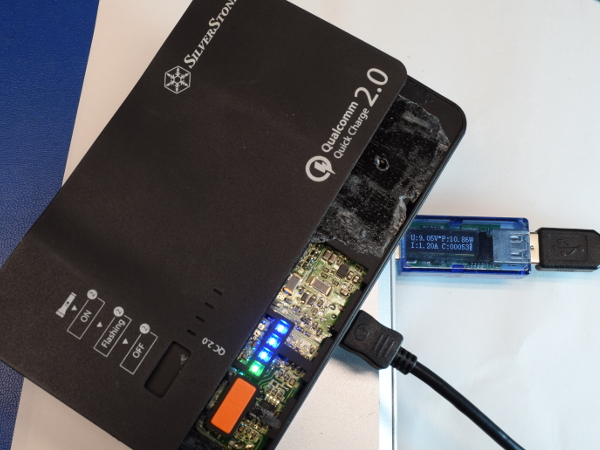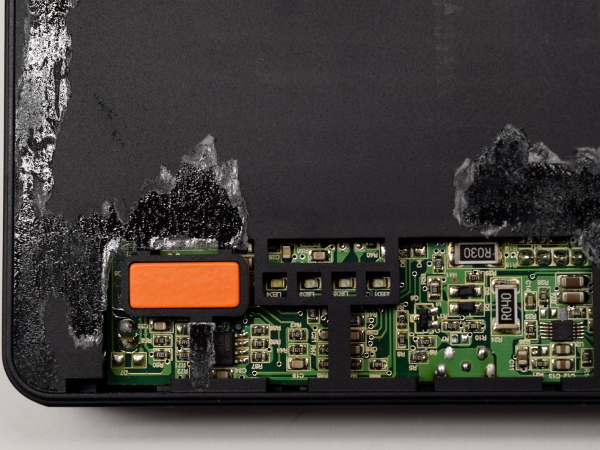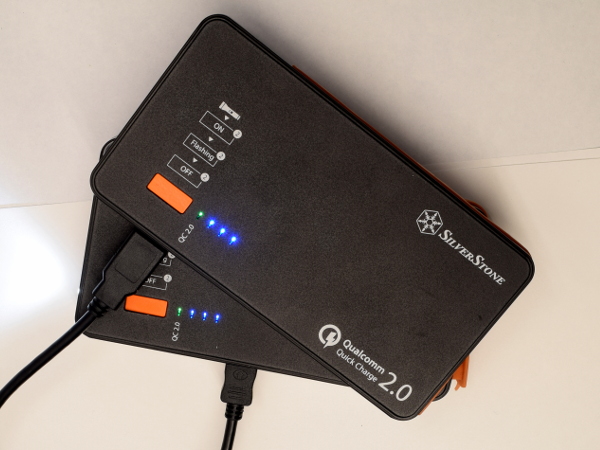Silverstone PB06 USB Power Bank Tear-Down
Quick Charge Test
Does Quick Charge actually work? Since my collection of QC 2.0 chargers is rather sparse, I chose to test this by plugging one PB06 into the other with a USB power meter in-between. On the top unit being charged, the green LED lights up to indicate that QC is active with my power meter reporting 1.2A and 9.05V. On the sending unit, which I flipped face-down so the meter would face up, the QC LED flashes green to let you know that QC is being used.
Out of curiosity, I tried daisy-chaining the PB06 to SilverStone’s UC01 AC charger and my tablet to find out how it handled that. I was slightly disappointed to see that charging the PB06 inhibits its output, despite the input and output having independent switching regulators.
MORE: SilverStone Stash Tour
MORE: Best Deals
DC Output Quality
How good is the output? Providing 1.7A at 9.05V, ripples are nearly 1.5V peak to peak with a switching frequency of only 65 kHz instead of the 300 kHz I expected upon seeing a 4.7µH inductor. On second thought, the inductor’s large physical size (the tall cube nestled between the Micro-B and battery connectors) did hint that it might be operating at a much higher magnetic flux (higher peak current) than a 300 kHz circuit would have required. Operating at a higher frequency could have easily reduced ripples by an order of magnitude.
MORE: SilverStone Stash Tour
MORE: Best Deals
Breezy Board
When I told SilverStone that I had opened the PB06, I was advised not to put it back together due to the boards supposedly being highly susceptible to dust. That did not seem to make much sense to me, and after some more probing it turned out that the crux of the issue is concern that the aluminum cover will not adequately seal the exposed PCB area. I agree with this. The warped aluminum sheets would require significant work to flatten, along with a new adhesive film, before they can be put back on properly.
Why not go for full plastic coverage? The answer I received is simple: re-purposed molds from some other product. Since normal people won’t be removing the aluminum cover, it won't be a significant issue.
Get Tom's Hardware's best news and in-depth reviews, straight to your inbox.
MORE: SilverStone Stash Tour
MORE: Best Deals
Needs More Work
So, what’s good about the PB06?
- Genuine capacity rating based on my rough tests
- QC 2.0
- Can start a car at -12°C, which is impressive for 3300mAh cells in a pocket-sized form factor
- Convenient flashlight (albeit inefficient)
What isn't so good, based on my limited sample size of two?
- Questionable micro-B connector soldering
- Loose cover on the always-on 12V port
With a few simple design and manufacturing tweaks backed by better quality assurance, SilverStone’s PB06 would be a nice little power bank. Also, a third unit should be on its way as I write this, so I'll let you know what I find in the comments or in a follow-up story. Do you think I will strike out a third time?
MORE: SilverStone Stash Tour
MORE: Best Deals
-
Daniel Sauvageau For those wondering how that third unit turned out, its 12V cover is in-between the first two: tight enough not to slip out on its own, but not snug enough to stay put completely either. So far, the micro-B connector hasn't broken off from mild intentional abuse.Reply -
alextheblue For those who want jump-starting first, with a dash of USB charging, Noco's Genius Boost GB40 is solid. The GB40 is rated at 1000A "3 seconds" which falls somewhere between cranking and peak amps. They have even more powerful options too. They're pricey unless you find a good deal. Other good-looking (brand and otherwise) options I've run across that prioritize jump starting but still have decent USB 5V capability:Reply
- Omega's 80600. 350/700A peak. I've used this model. Also sold under Pro-Lift I-8006 series. 6000 rated mAh 5V capacity IIRC.
- Omega's harder-to-find 81100 unit. 400/800 amps - rated 11000 mAh
- Ravpower's RP-PB053 600A peak unit. 18000 mAh "raw"/unrated capacity.
- Ravpower's RP-PB063 1000A peak unit. 14000 mAh - rated?
- Bolt Power's D29 450/900A peak unit. 18000 unrated mAh.
- Wagan's 7506 V10 "400"/700A peak unit.
Of those probably the most interesting units is Ravpower's RP-PB063. It's still geared towards jump starting but it has faster charging than any of the other ones above - one of its USB ports even supports QC 3.0. -
Olle P Overall a nice in-depth review!Reply
Two oddities though:
1. This is NOT a 10Ah battery pack. Since the cells are connected in series it's just 3,3Ah.
2. The ripple is measured at ~9V. Shouldn't the USB output be 5.0V? -
Daniel Sauvageau Reply
Most power banks report the total combined rating of their lithium cells. Travel restrictions don't care if the cells are in series or parallel, all they care about is the total Wh or Ah capacity of the underlying cells. For the end-users, 50Wh is 50Wh regardless of series or parallel as well. When you buy a 5.2Ah power bank, you usually find a pair of 2600mAh cells in parallel but this only gives you ~4V, so you need a boost converter to get that up to ~5.1V. Since the PB06's battery voltage is 12.6V, it uses a buck regulator to bring that down to 5V or 9V instead.19542706 said:Overall a nice in-depth review!
Two oddities though:
1. This is NOT a 10Ah battery pack. Since the cells are connected in series it's just 3,3Ah.
2. The ripple is measured at ~9V. Shouldn't the USB output be 5.0V?
I suppose I should have tested at 5V too instead of 9V Quick Charge. Same inductor and switching frequency though since all the QC voltage selection chip does is change the switching regulator's feedback voltage divider, so ripples would still be quite significant at about half as much. -
Olle P Reply
There's a HUGE difference between watthours (stored energy) and amperehours (battery capacity), since the former takes the voltage into account.19543501 said:
Most power banks report the total combined rating of their lithium cells. Travel restrictions don't care if the cells are in series or parallel, all they care about is the total Wh or Ah capacity of the underlying cells. For the end-users, 50Wh is 50Wh regardless of series or parallel as well.19542706 said:1. This is NOT a 10Ah battery pack. Since the cells are connected in series it's just 3,3Ah.
The package clearly states 10 Ah, which it's not.
It's 3.3 Ah, 36 Wh.



